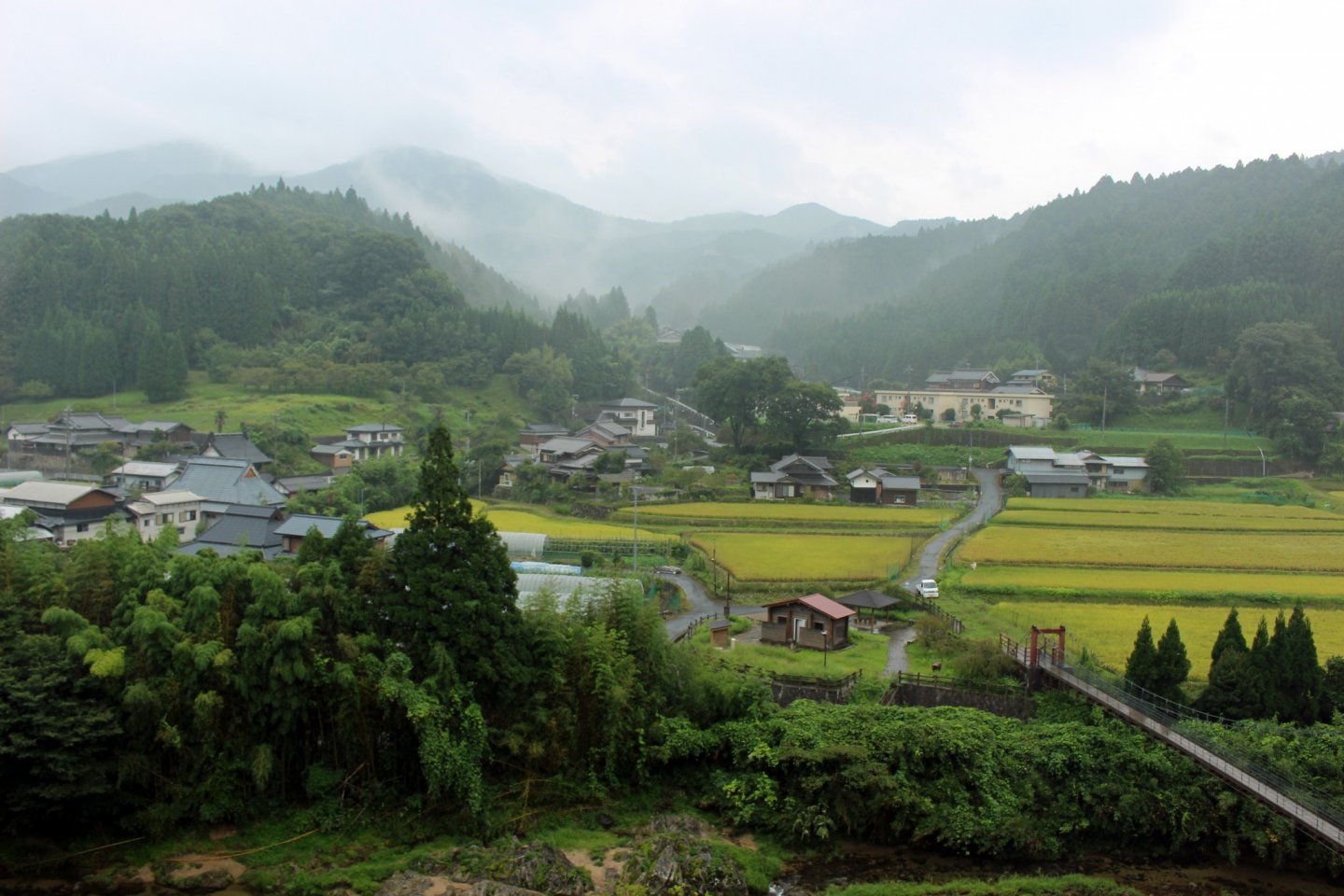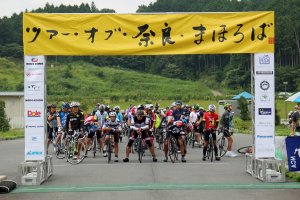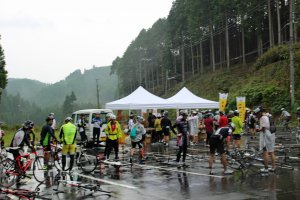The back wheel of one of my cycling companion’s bicycles threw a huge rooster tail up off of the rain slicked road as we pedaled through a saddle between two hills. When we approached the crest of the second hill I put on a burst of speed building up the momentum to climb the next steeper hill and blazed past my group’s leading rider (“Oh no you don’t!” He said as I came by). At the crest of the hill I shifted into top gear and pedaled until I could no longer keep pace with the bike’s speed. The rain drops stung as they struck my face but I squinted my eyes, tilted my head forward and pushed on toward the next hill. The rain and heavy clouds were not so thick that they hid the countryside, instead they embellished it filling the valleys and spaces between the layers of mountains with streamers of gray and white fog, a realization of many of the old time paintings and uke-yo block prints I’d seen overseas and in tokonoma alcoves and on shoji sliding doors in Japan. 35 kilometers down, 38 kilometers to go.
The point of a bike race is to lead the pack, maybe set a record time, and above all, win. Unless you’ve had the chance to train that’s hard to do. The point of the Tour of Nara Mahoroba is to take your time and enjoy the sights and sounds of rural Nara while challenging yourself to complete a long distance cycling course. The Tour of Nara Mahoroba has three courses for participants to choose from based on their level of fitness and riding ability. The 34.5 kilometer (~21.4 mile) long Uda loop is for beginning riders and children. There are only three hill climbs throughout the whole course totaling 366 meters of elevation gain between them, and riders are given from 10am to 4pm to complete the course (there’s also plenty to see along the way). Expert riders or riders with a great deal of training under their belt can challenge themselves to complete the massive Higashi Yoshino-Yamazoe Course. At 103.8 kilometers (~64.5 miles) in length and with 1959 meters (~6,425 feet) of total elevation gain across all the hills on the course and a time limit of just 8 hours (8am-4pm) to complete the course it’s tough enough to give even Lance Armstrong a run for his money. Support in the form of snack, lunch and hydration aid stations/checkpoints, and safety and sweep vehicles are offered on all the courses to allow for a fun, relaxed and safe experience. I elected to ride the (advanced) intermediate level Soni-Mitsue Course. At 73.1 kilometers (~45.4 miles) in length it would be the longest bike ride I’d ever done. I was also confident that I could tackle the 1402 meters (4,598 feet) of total elevation gain across all its hills.
After signing in, changing and meeting my companion rider and the bike that had been prepared for me, we assembled on the starting grid (for an event about enjoying the ride it sure felt like a race to me). From 9am riders were sent out in waves of 5. My group was given the off and the adventure began. I found the aid stations/checkpoints to be very well spaced and stocked. The first one, at the top of a long hill with a steep crest, came a little over an hour in at about the 10km point. It was stocked with bottled water, onigiri and sweet bread and provided the recharge I didn’t know I was in need of until after I had it. Its only drawback was the lack of a toilet. One more checkpoint came before the lunch stop at about the 20km point just outside central Soni-mura. It had bananas, bottled water, toilets and the first view of the Matterhorn-like Yoroi-dake Mountain looming out of the clouds.
The climb up to the lunch stop at Soni Kogen National Youth House was possibly the hardest of the tour but the shioyaki (salted and skewered whole ayu fish roasted over charcoal), kakinohazushi, miso soup and hot tea at the lunch stop made the effort well worth it. There would be only one more hill climb after lunch, and the downhill ride from Soni Kogen down through Mitsue-mura and the next aid station was a lot of fun despite rain. Aid Station number 4 had warm coffee, mochi and another local sweet available for the riders. Absolutely perfect after the rain.
We were retracing our path after the 4th aid station. Aid Station number 5 is also Aid Station number 1 and the climb to it was longer from this, the east side. The station was out of onigiri by this time but there was still sweet bread and bottled water. It was all downhill from here to the final aid station in the small village of takagi where more tea, short cake and well maintained toilets awaited. After the final aid station, and being distracted by Mii and Sumisaka Shrines, my companions and I completed the final 15 kilometers and returned to the start point in Uda. Picture taking, dallying at the aid stations and trying to wait out the rain at Soni Kogen meant we were the last riders to arrive. We were also 7 minutes past the 4pm time limit. No one cared and congratulated us on our efforts. Never has last place felt so good!
Participation in Tour of Nara Mahoroba Uda Course costs ¥4,000 for adults and ¥2,000 for children in 5th grade through junior high school 3rd grade, participation is limited to 200 riders. The Soni-Mitsue and Higashi Yoshino-Yamazoe Courses both cost ¥6,000 and are limited to 300 participants each. I very much enjoyed the Soni-Mitsue Course and would love to do it again without the rain so that I can see the mountains better, take better photos, explore the mountain meadow and Soni Kogen and improve my time (if possible with all the photo taking and exploring). The exercise, the scenery and sharing the adventure made for a grand day out. Ridden a bike lately? Happy travels!
































